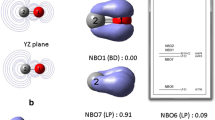Abstract
A series of CNDO/2 molecular orbital properties were evaluated to determine their utility in parameterizing chemical reactivities. Some of these indices were used previously for only Π electron methods and were extended here to include the σ framework. Theoretical rationales were given for this extension to the semi-empirical all valence electron methods. Four systems, the aromatic hydrocarbons, the benzene derivatives, the substituted benzoic acids, and the substituted phenyl amines, were studied to test how well these indices can parameterize chemical reactivities. This study focused on reactions involving both σ and π electrons where the reactive site is not necessarily on the aromatic framework. For the nonplanar and heteropolar systems, these indices performed as well as the Hückel method did for the classical aromatics. These CNDO indices should perform effectively in multivariable regressions to parameterize the reactivities for more complicated problems such as those encountered in quantitative structure activity relationships of drugs.
Similar content being viewed by others
References and Notes
For example, see Streitweiser, Jr., A.: Molecular orbital theory for organic chemist, Chap. 11. New York: Wiley, N.Y. 1961; or Murrell, J. N., Harget, A. J.: Semi-empirical self-consistent-field molecular orbital theory of molecules, Chap. 1. New York: Wiley, N.Y., 1972
Kang, S., Beveridge, D. L.: Theoret. Chim. Acta (Berl.) 22, 312 (1971)
Kang, S., Cho, M.-H.: Int. J. Quant. Chem., Symp. No. 7, 319 (1973)
Streitweiser, Jr., A., Mowery, P. C., Jesaitis, R. G., Lewis, A.: J. Am. Chem. Soc. 92 6529 (1970)
Brownlee, R. T. C., Taft, R. W.: J. Am. Chem. Soc. 90, 6537 (1968)
McKelvey, J. M., Alexandratos, S., Streitweiser, Jr., A., Abboud, J.-L. M., Hehre, W. J.: J. Am. Chem. Soc. 98, 244 (1976)
Wohl, A. J.: Drug design, Ariens, E. J. Ed., Chap. 4. New York; Academic Press, N.Y. 1971
Coulson, C. A., Longuet Higgins, H. C.: Proc. Roy. Soc. (London) 192A, 16 (1947), and references therein
Fukui, K., Yonezawa, T., Shingu, N.: J. Chem. Phys. 20, 722 (1952); Fukui, K., Yonezawa, T., Nagata, C., Shingu, H.: J. Chem. Phys. 22, 1433 (1954); Fukui, K., Yonezawa, T., Nagata, C.: Bull. Chem. Soc. Japan 27, 423 (1954)
Greenwood, H. H., McWeeny, R.: Advances in physical organic chemistry, V. Gold, Ed., Vol. 4, Chap. 3. New York: Academic Press, N.Y. 1966
Johnson, C. D.: The Hammett equation, London: The Cambridge University Press, 1973
Stock, C. M., Brown, H. C.: A quantitative treatment of directive effects in aromatic substitution, in Adv. Phys. Org. Chem., Vol. 1, V. Gold, Ed., P 35. London: Academic Press, 1963
Helvie, W. J., Radom, L., Pople, J. A.: J. Am. Chem. Soc., 94, 1496 (1972)
Swain, C. G., Lupton, E. C.: J. Am. Chem. Soc., 90, 4328 (1968)
Author information
Authors and Affiliations
Rights and permissions
About this article
Cite this article
Brown, R.E., Simas, A.M. On the applicability of CNDO indices for the prediction of chemical reactivity. Theoret. Chim. Acta 62, 1–16 (1982). https://doi.org/10.1007/BF00551049
Received:
Issue Date:
DOI: https://doi.org/10.1007/BF00551049




